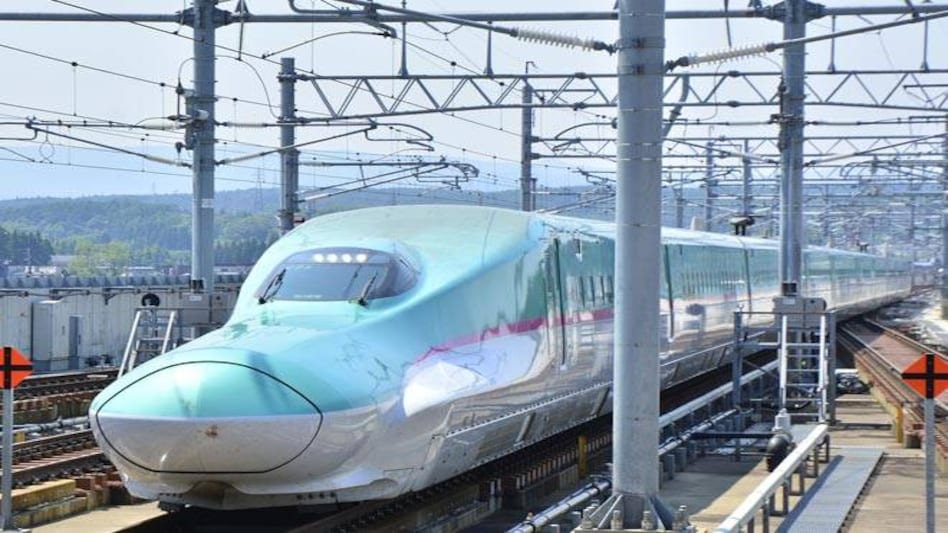

India has inched closer to getting a bullet train of its own after Prime Minister Narendra Modi and his Japanese counterpart Shinzo Abe laid the foundation for a high-speed train network. Both heads of state announced the launch of Mumbai-Ahmedabad high-speed rail (MAHSR) project in Sabarmati today. It will cost Rs 1.1 lakh crore to see this ambitious project through, though.
Indian Railways, with help from Japan government, is now set to begin work to set up a 500-km route for high-speed trains between Ahmedabad and Mumbai. Railways Minister Piyush Goyal has indicated that the bullet train project will be completed by August 15, 2022, when India completes the 75 years of its independence, one year before the official deadline of December 2023. Once up and running, the maglev trains on the Mumbai-Ahmedabad high-speed rail network will run at average speeds of 250 km/h. The bullet trains expected to run on the route can reach high speeds of 320 km/h.
Japan has offered to lend India a soft loan of Rs 88,000 crore at an interest of 0.1 per cent. The loan will have to be paid in the course of 50 years, with a moratorium of 15 years. Although, the bullet train project brings with it several promising prospects, there also exist hurdles which might hinder them. Here's a look at both:
Also Read: Lucknow Metro seized 20 kg tobacco on Day 1; wall defaced with pan masala stains
How India benefits from bullet train
1. High-speed connectivity - The bullet train running between Ahmedabad and Mumbai will cover the distance of 508 km within two to three hours. The project is supposed to connect bustling economic corridors in the states of Gujarat and Maharashtra. This will facilitate economic growth. Smaller cities along the way can also be connected with high-speed transit facility to these economic centres through the bullet train network.
2. Employment - The bullet train project will bring speed and employment, PM Modi said during its inauguration. The bullet train project is expected to create 4,000 direct job opportunities, along with 20,000 indirect jobs. 20,000 construction workers will also be employed during the set up period of Ahmedabad-Mumbai bullet train.
3. Urban expansion - New bullet train stations set to come up along the route will attract urban growth. This will again shift the pressure of urbanisation from the existing urban centres.
4. Open new avenues - When completed, the Ahmedabad-Mumbai bullet train project will present as a favourable destination for high-speed train technologies, attracting other parties working in the field.
Also Read: Over 500 people get stuck inside Lucknow Metro on first day of commercial run
What challenges lay ahead
1. Land acquisition - Acquiring new land pieces for laying down the tracks for bullet trains and constructing new stations might face legal hindrances, delaying the process. As per plans by the government, 92 per cent of the 508 km of tracks will be elevated, but six per cent will be through tunnels and rest will be on ground level. The pillars for elevated tracks have to be built in a way to reduce the area they take up.
Land acquisition has already hit a hitch in Mumbai where land could not be acquired in a crucial economic zone. Railways has urged that necessary construction be done on its land, but this might affect the reach of the project.
2. Stoppages - With limited stoppages (only two in Vadodra and Surat), the Ahmedabad-Mumbai bullet train will complete its journey in 2 hours, where increasing the stoppages will increase the journey time up to three hours. This will also bring the average speed down.
There have been instances where fast trains have been slowed down to include station along their routes. If this happens to bullet trains, it will defeat the purpose of high-speed connectivity that the project promises.
3. Profitability - The origin stations - Ahmedabad and Mumbai - have airports and passengers from these cities could consider taking a flight instead of boarding the bullet train. Although ticket prices are yet to be finalised, they are expected to cost somewhat close to air tickets. This might restrict frequency of passengers opting to travel with bullet trains, hampering profitability.
A total of 80 per cent of the funds for the project will come from Japan, and will have to be returned after a period of 15 years. The profits this project make will decide how easy or difficult it will be for India to pay this loan back.
Also Read: Switch to clean vehicles or be bulldozed: Nitin Gadkari to carmakers
Copyright©2025 Living Media India Limited. For reprint rights: Syndications Today